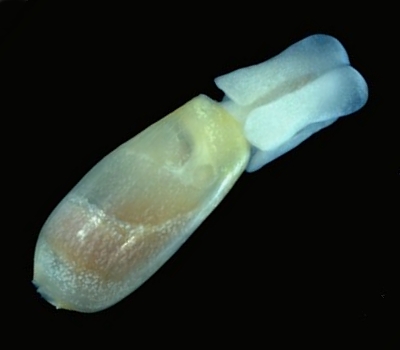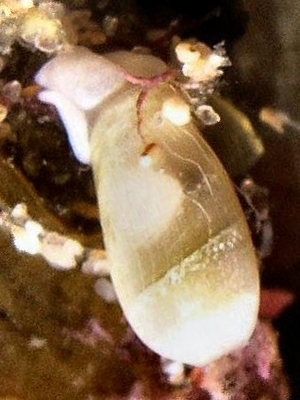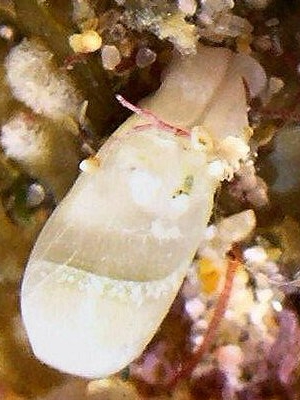
Ascobulla, Cylindrobulla spp.
Order: SACOGLOSSA
Superfamily: OXYNOOIDEA
Family: Volvatellidae
PHOTO
Heron Is, Capricorn Group, Great Barrier Reef, Queensland, Australia, June 1983. In sand at base of Caulerpa. Crawling length of animal & shell 11 mm. Photographer: Bill Rudman
The genus Cylindrobulla was proposed (Fischer, 1857) for small opisthobranchs with a thinly calcified bubble-shaped shell. When live specimens were studied they were found to have a cephalaspid like head shield. Over many years they have been considered primitive opisthobranchs and linked to the cephalaspideans, Akera-like aplysiids, diaphanids and sacoglossans. The anatomy of a number of species has been studied and while many have a sacoglossan-like radula, two west Atlantic species, including the type species, C. beaui Fischer, 1857 have a rather different shaped radular more reminiscent of the diaphanids. This has led to the erection of a new genus Ascobulla Marcus, 1972 for those species with a sacoglossan like tooth. See my separate message [#18254 ] for further discussion.
Both species of Cylindrobulla [with solid triangular denticulate teeth] feed on species of calcified Halimeda, while those with the dagger-shaped sacoglossan teeth [Ascobulla] feed on algae of the genus Caulerpa, which have a relatively soft easily piercible cell wall. They are usually found burrowing in coral sand near algal beds.
Jensen & Wells (1990) suggest the shells of the two genera can be distinguished as follows: "Ascobulla have an almost straight outer lip, a relatively shallow apical area with the protoconch in the centre of a domed inner whorl, and an apical keel continuing in the reflected inner lip. Shells of species .... [of] Cylindrobulla, on the other hand, have a curved outer lip, a deeply sunken apical area with the protoconch completely hidden in the somewhat acentric spire. The apical keel appears to terminate independently on the body whorl."
I can see no way to separate species of Ascobulla and Cylindrobulla from photographs, so unless photographs can be linked to anatomical studies of the actual specimens photographed, I will place them all on this page.
- Clark, K. B. and DeFreese, D. (1987) Population ecology of Caribbean ascoglossa (Mollusca: Opisthobranchia): a study of specialized algal herbivores. American Malacological Union Bulletin 5: 259-280.
- DeFreese, D. E. (1987) Ecology and burrowing behaviour of Ascobulla ulla (Opisthobranchia: Ascoglossa). The Veliger 30: 40-45.
- Fasulo, G., Gaglini, A., and Terreni, G. (1982) Nota su recenti ritrovamenti di un mollusco poco noto, Cylindrobulla fragilis (Jeffreys, 1856) (Gastropoda: Opisthobranchia) e considerazioni sulla sua collacazione sistematica. Notizario CISMA 3: 27-32.
- Hamatani, I. (1971) A new species of Cylindrobulla, sacoglossan opisthobranch, from California: with a comparison with C. japonica Hamatani, 1969. Publications of the Seto Marine Biological Laboratory 19: 111-117.
- Hamatani, I. (1969) A new species of the rare shelled sacoglossan genus Cylindrobulla, from Middle Japan (Opisthobranchiata). Publications of the Seto Marine Biological Laboratory 17: 171-174.
- Ichikawa, M. (1993) Saccoglossa (Opisthobranchia) from the Ryukyu Islands. Publications of the Seto Marine Biological Laboratory 36: 119-139.
- Jensen, K. R. (1983) Factors affecting feeding selectivity in herbivorous ascoglossa (Mollusca: Opisthobranchia). Journal of Experimental Marine Biology and Ecology 66: 135-148.
- Jensen, K. R. (1989) A new species of Cylindrobulla from Phuket, Thailand, with a discussion of the systematic affiliation of the genus. PhuketMarineBiologicalCenter, Research Bulletin 52: 1-11.
- Jensen, K.R. (1996) Phylogenetic systematics and classification of the Sacoglossa (Mollusca, Gastropoda, Opisthobranchia). Philosophical Transactions of the Royal Society of London, B 351, 91-122.
- Jensen, K. R. and Wells, F. E. (1990) Sacoglossa (= Ascoglossa) (Mollusca, Opisthobranchia) from southern Western Australia . In: Wells, F.E., Walker, D.I., Kirkman, H. & Lethbridge, R. Proceedings of the Third International Marine Biological Workshop: The Marine Flora and Fauna of Albany, Western Australia. WesternAustralianMuseum, Perth, Vol. 1: 297-331.
- Lin, G. (1978) A new species of Cylindrobulla (Opisthobranchia) of the Xisha Islands, Guangdong Province, China. Oceanologia et Limnologia Sinica 9: 95-98.
- Marcus, E. and Marcus, E. (1956) On the tectibranch Gastropod Cylindrobulla. Dos Anais da Academia Brasiliera de Ciencas 28: 119-130.
- Marcus, E. and Marcus, E. (1970) Opisthobranchs from Curacao and faunistically related regions. Studies on the Fauna of Curacaoand other CaribbeanIslands 33: 1-129.
- Marcus, E. (1972) On some opisthobranchs from Florida. Bulletin of Marine Science 22: 284-308.
- Melvill, J. C. (1918) Descriptions of thirty-four species of marine mollusca from the Persian Gulf, Gulf of Oman, and Arabian Sea, collected by Mr. F. W. Townsend. Annals and Magazine of Natural History (9), 1: 137-158, 2 pls.
- Mikkelsen, P. M. (1998) Cylindrobulla and Ascobulla in the western Atlantic (Gastropoda, Opisthobranchia, Sacoglossa): Systematic review, description of a new species, and phylogenetic reanalysis. Zoologica Scripta 27: 49-71.
Rudman, W.B., 2006 (November 8) Ascobulla, Cylindrobulla spp. [In] Sea Slug Forum. Australian Museum, Sydney. Available from http://www.seaslugforum.net/find/ascospp
Related messages
Re: Ascobulla and Cylindrobulla - are the differences real?
November 10, 2006
From: Kathe R. Jensen
Concerning message #18254:
Dear Bill,
I don't think we really disagree on this. Paula Mikkelsen would like to include Cylindrobulla in the Sacoglossa, and I would like to see them just outside (sister group). The important character is not the shape of the radular teeth. Bosellia mimetica, which definitely feeds on Halimeda, has short and broad teeth, not too different from those of Cylindrobulla, which may feed on Halimeda. The important character is the formation of the ascus-muscle as part of the pharynx. In Cylindrobulla the odontophore is long and "free" inside the pharyngeal bulb (as in most cephalaspids). In Ascobulla and all other sacoglossans longitudinal muscles surround the descending limb of the radula and an ascus is formed at the posterior end. In Cylindrobulla the old, used teeth just pile up at the posterior end of the radula. The formation of the ascus-muscle and the fundtional separation of ascending and descending limbs are what made the piercing-sucking feeding mechanism possible, and thus are true "innovations", which allowed a radiation of species. For schematic drawings of pharynx musculature see Jensen 1993 and 1996.
-
Jensen, K.R. (1993). Sacoglossa (Mollusca: Opisthobranchia) - specialist herbivores and partial predators: integrating ecological, physiological and morphological data. [In:] The Marine Biology of the South China Sea. Proceedings of the First International Conference on the Marine Biology of Hong Kong and the South China Sea. Hong Kong, 28 Oct. - 3 Nov. 1990 (Ed. B. Morton). Hong Kong University Press, Hong Kong, pp. 437-458.
-
Jensen, K.R. 1996. The Diaphanidae as a possible sister group of the Sacoglossa (Gastropoda, Opisthobranchia). [In] Origin and evolutionary radiation of the Mollusca (J. Taylor, ed.). Oxford University Press, Oxford, pp. 231-247.
Best wishes,
Kathe
krjensen@snm.ku.dk
Jensen, K.R., 2006 (Nov 10) Re: Ascobulla and Cylindrobulla - are the differences real?. [Message in] Sea Slug Forum. Australian Museum, Sydney. Available from http://www.seaslugforum.net/find/18263Dear Kathe,
Thanks for your quick response. I've added a few more references below if anyone wants to explore this more deeply. You are right, I should have said 'foregut anatomy' because obviously the teeth aren't independent of what makes them work. I guess what seems to have got lost in the phylogenetic discussion is that the Cylindrobulla - Ascobulla leap (I hesitate to say quantum leap) looks to me like an evolutionary moment, frozen in time.
In one of your interesting reviews of sacoglossan evolution you say: "The synapomorphies delimiting the Sacoglossa from the Cylindrobullidae are almost all connected to the anterior alimentary system ...... It is unlikely that these synapomorphies developed independendently .... It is apparently the acquisition of these 'key innovations' which have enabled the Sacoglossa to speciate profusely, whereas the Cylindrobullidae has remained a monogeneric group." (Jensen, 1997: 318)
I guess it is how you look at this. To me the Cylindrobullidae were not an evolutionary failure - it was their evolution of a new foregut which gave rise to the Sacoglossa. To say they are not sacoglossans reminds me of 19th century melodramas where the socially successful son is embarassed by his lower class parents so cuts off all links to them.
In the review I mention above you conclude that "the ancestral sacoglossan probably fed on calcified, filamentous ancestors of Halimeda" (Jensen, 1997: 329). This again fits with our knowledge of Cylindrobulla. I realise that to include Cylindrobulla within the Sacoglossa would cause problems in defining the clade. My belief is that that is a problem we should face. I realise that it is probably a problem for cladistic methodology as well - but surely cladistics is our tool, not our master.
- Jensen, K.R. (1980) A review of saccoglossan diets with comparative notes on radular and buccal anatomy. Malacological Review, 13: 55-77.
- Jensen, K.R. (1997) Evolution of the Sacoglossa (Mollusca, Opisthobranchia) and the Ecological associations with their food plants. Evolutionary Ecology, 11: 301-335.
Best wishes,
Bill Rudman
Ascobulla and Cylindrobulla - are the differences real?
November 9, 2006
From: Bill Rudman

Denis Riek's message [#17552] seemed an appropriate time to post some thoughts I have on the genera Cylindrobulla and Ascobulla.
Photo: Heron Is, Capricorn Group, Great Barrier Reef, Queensland, Australia, June 1983. Photographer: Bill Rudman
The genus Cylindrobulla was proposed (Fischer, 1857) for small opisthobranchs with a thinly calcified, bubble-shaped shell. When live specimens were later studied they were found to have a cephalaspid like head shield and over the years they have been considered primitive opisthobranchs, and linked to the cephalaspideans, Akera-like aplysiids, diaphanids and sacoglossans. The anatomy of a number of species has been studied and while many have a sacoglossan-like radula, two west Atlantic species, including the type species, C. beaui Fischer, 1857, have a rather different shaped radular more reminiscent of the diaphanids. This led to the erection of a new genus, Ascobulla Marcus, 1972, for those species with a sacoglossan-like tooth.
More recently, a number of cladistic analyses of the phylogenetic relationships of these animals have concluded that while Ascobulla is a good, if primitive, sacoglossan, Cylindrobulla is quite unrelated, perhaps a sister group to the sacoglossans, perhaps a diaphanid or even a cephalaspidean. I am very uncomfortable with this hypothesis. One unfortunate aspect of cladistic analysis is that often the need for characters, leads to the loss of the whole picture - a case of not being able to see the forest because the trees get in the way. I have pored over all the literature on these animals and the only difference is the shape of the radular morphology. In some analyses the structure of the radula teeth is broken into 5 or more characters, but when we get down to reality, what we are dealing with is a single evolutionary event. Not surprising to me is the fact that this difference in morphology is directly correlated with the known feeding biology. Both species of Cylindrobulla [with solid triangular denticulate teeth] feed on species of calcified Halimeda, while those with the dagger-shaped sacoglossan teeth [Ascobulla] feed on algae of the genus Caulerpa, which have a relatively soft easily piercible cell wall. It seems to me that the simple interpretation of the Ascobulla - Cylindrobulla controversy is that they are an extremely closely related group of primitive sacoglossans. One simple scenario is that the ones feeding on Caulerpa the group that evolved the classic sacoglossan dagger-shaped tooth after moving from Halimeda - which would make them are basal to all sacoglossans. If so the two on Halimeda may be a link to the Diaphanidae, which has often featured in discussions on the origin of the sacoglossans.
Whatever the scenario, it seems very strange to me that this group of animals with so much in common, can be split into two totally unrelated phylogenetic groups on the shape of the radula. Surely changes like this are how evolution works. We only have to look at the amazing radula changes that occur in the Turridae and other toxoglossan gastropods to realise that in some phylogenetic groups, differences in usually stable characters, like tooth morphology, should not automatically be considered evidence in favour of phylogenetic distance.
Whatever the 'truth' is, I can see no way to separate species of Ascobulla and Cylindrobulla from photographs, so unless photographs can be linked to anatomical studies of the actual specimens photographed, I will place them all on this page.
- Clark, K. B. and DeFreese, D. (1987) Population ecology of Caribbean ascoglossa (Mollusca: Opisthobranchia): a study of specialized algal herbivores. American Malacological Union Bulletin 5: 259-280.
- DeFreese, D. E. (1987) Ecology and burrowing behaviour of Ascobulla ulla (Opisthobranchia: Ascoglossa). The Veliger 30: 40-45.
- Fasulo, G., Gaglini, A., and Terreni, G. (1982) Nota su recenti ritrovamenti di un mollusco poco noto, Cylindrobulla fragilis (Jeffreys, 1856) (Gastropoda: Opisthobranchia) e considerazioni sulla sua collacazione sistematica. Notizario CISMA 3: 27-32.
- Hamatani, I. (1971) A new species of Cylindrobulla, sacoglossan opisthobranch, from California: with a comparison with C. japonica Hamatani, 1969. Publications of the Seto Marine Biological Laboratory 19: 111-117.
- Hamatani, I. (1969) A new species of the rare shelled sacoglossan genus Cylindrobulla, from Middle Japan (Opisthobranchiata). Publications of the Seto Marine Biological Laboratory 17: 171-174.
- Ichikawa, M. (1993) Saccoglossa (Opisthobranchia) from the Ryukyu Islands. Publications of the Seto Marine Biological Laboratory 36: 119-139.
- Jensen, K. R. (1983) Factors affecting feeding selectivity in herbivorous ascoglossa (Mollusca: Opisthobranchia). Journal of Experimental Marine Biology and Ecology 66: 135-148.
- Jensen, K. R. (1989) A new species of Cylindrobulla from Phuket, Thailand, with a discussion of the systematic affiliation of the genus. PhuketMarineBiologicalCenter, Research Bulletin 52: 1-11.
- Jensen, K.R. (1996) Phylogenetic systematics and classification of the Sacoglossa (Mollusca, Gastropoda, Opisthobranchia). Philosophical Transactions of the Royal Society of London, B 351, 91-122.
- Jensen, K. R. and Wells, F. E. (1990) Sacoglossa (= Ascoglossa) (Mollusca, Opisthobranchia) from southern Western Australia . In: Wells, F.E., Walker, D.I., Kirkman, H. & Lethbridge, R. Proceedings of the Third International Marine Biological Workshop: The Marine Flora and Fauna of Albany, Western Australia. WesternAustralianMuseum, Perth, Vol. 1: 297-331.
- Lin, G. (1978) A new species of Cylindrobulla (Opisthobranchia) of the Xisha Islands, Guangdong Province, China. Oceanologia et Limnologia Sinica 9: 95-98.
- Marcus, E. and Marcus, E. (1956) On the tectibranch Gastropod Cylindrobulla. Dos Anais da Academia Brasiliera de Ciencas 28: 119-130.
- Marcus, E. and Marcus, E. (1970) Opisthobranchs from Curacao and faunistically related regions. Studies on the Fauna of Curacaoand other CaribbeanIslands 33: 1-129.
- Marcus, E. (1972) On some opisthobranchs from Florida. Bulletin of Marine Science 22: 284-308.
- Melvill, J. C. (1918) Descriptions of thirty-four species of marine mollusca from the Persian Gulf, Gulf of Oman, and Arabian Sea, collected by Mr. F. W. Townsend. Annals and Magazine of Natural History (9), 1: 137-158, 2 pls.
- Mikkelsen, P. M. (1998) Cylindrobulla and Ascobulla in the western Atlantic (Gastropoda, Opisthobranchia, Sacoglossa): Systematic review, description of a new species, and phylogenetic reanalysis. Zoologica Scripta 27: 49-71.
Ascobulla sp from Northern New South Wales
November 9, 2006
From: Denis Riek

Dear Bill,
This Ascobulla was found in Caulerpa peltata at Hastings Point at low tide level and at first I thought it was a Marginella. It released a white discharge when "disturbed". At only 4 mm these are the best shots I could get at the time, I have since found another but it was even smaller. It appears similar to Ascobulla japonica as shown on Bob Bolland's site.
Locality: Hastings Point, Dead low tide, Northern New South Wales, Australia, Pacific, 15 September 2005, In Caulerpa weed, rock reef , low tide. Length: 4 mm. Photographer: Denis Riek.
Regards
Denis
dwriek@optusnet.com


Dear Denis,
Thanks for these photos. I have been meaning to post some photos of these interesting animals on the Forum but as with many things, it's not a question of just posting some photos with a name. In this case I have been puzzling over Cylindrobulla and Ascobulla for some years. Basically I thinnk the separation of the two groups is artificial and that the only difference, which is the shape of the radular tooth, is more sensibly considered an indication of an evolutionary change in food rather than an indication that the two genera are quite unrelated. Have a look at my separate message [#18254 ]
Best wishes,
Bill Rudman
